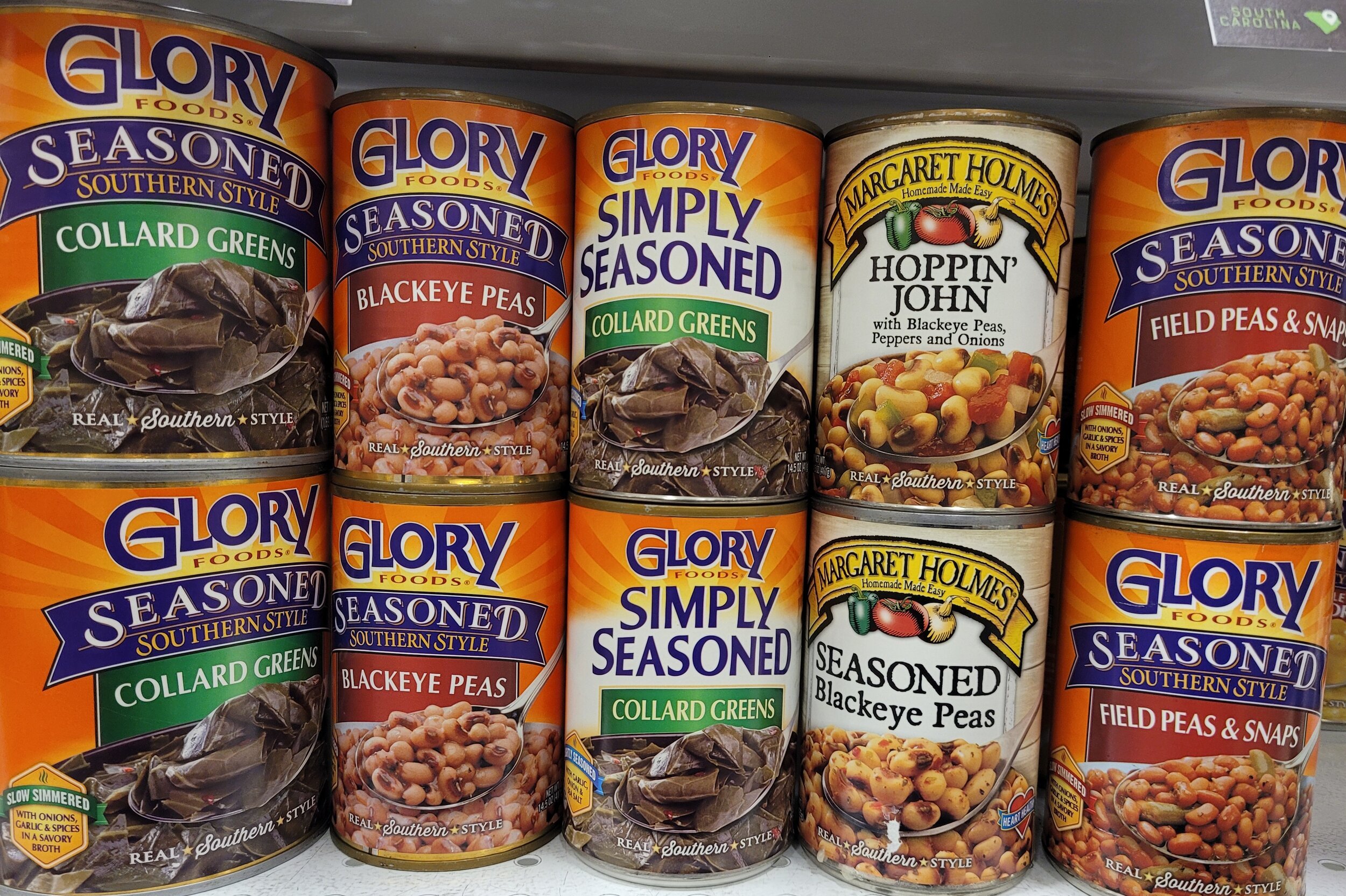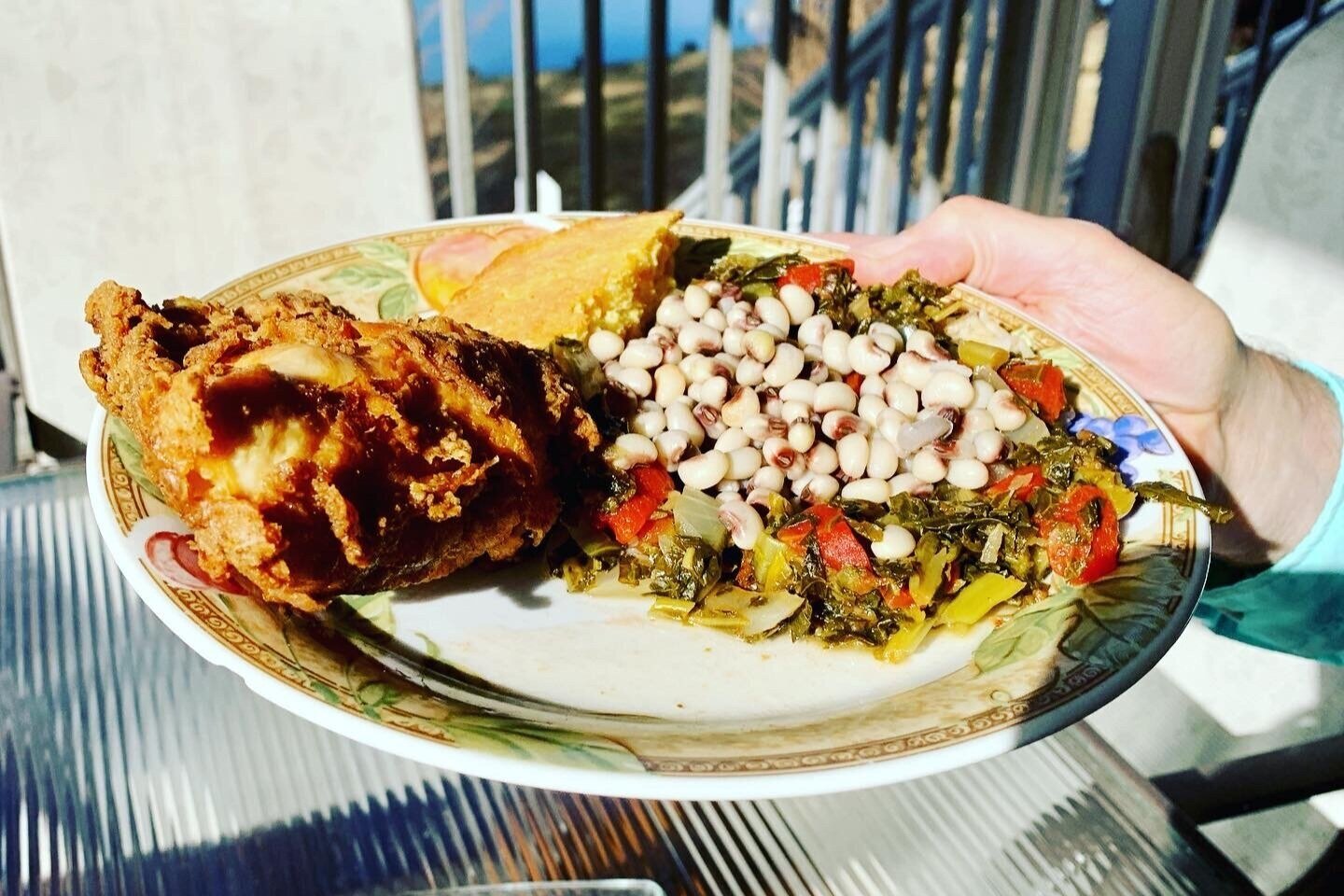Hoppin’ John and Collards Celebrating New Year’s Traditions 2021
By Lyssa Kligman Harvey and Rachel Barnett
Lyssa: The Jewish New Year, Rosh Hoshanah, takes place in the Fall of each year. To celebrate this holiday, I always make my Grandmother Ida’s Lukshen Kugel. It is a sweet Kugel with raisins and sour cream. It is traditional to eat something sweet for Rosh Hoshanah to bring sweetness to the New Year. For the January 1 New Year I have eaten black-eyed peas, or Hoppin’ John, and collards since I can remember. Little did I know until I perused an article in the October 6, 2016 edition of Southern Living Magazine that black-eyed peas are not only a traditional southern dish, but a long standing traditional Jewish New Year dish. In the article “Why we eat Black-Eyed Peas and Collards on New Years” Hannah Hayes notes “There is evidence that people ate black-eyed peas for luck as early as 500 A.D. as part of the Rosh Hoshanah meal. But the tradition of eating black-eyed peas with rice is African in origin and spread throughout the South, especially in the Carolinas, in the form of pilaus (perlo) or rice dishes simmered for a long time with chicken or shrimp. When black-eyed peas were added to the pilau, it became Hoppin’ John. “
Lyssa Harvey and Rachel Barnett at Clayton Rawls Farms
Eating Hoppin’ John is a southern tradition that is purported to ensure prosperity and health in the New Year. According to Robert Moss in his 2014 article from Serious Eats.com “The HistoricProblem with Hoppin’ John,” “The technique of cooking rice and beans together was African in origin, and it spread to every part of the Americas that had a significant African presence. The original ingredients of Hoppin’ John are simple: one pound of bacon, one pint of peas, and one pint of rice. The earliest appearance in print seems to be in Sarah Rutledge’s The Carolina Housewife (1847) and it’s important to note that everything was cooked together in the same pot. Though clearly African in origin, its inclusion in cookbooks like Sarah Rutledge’s Carolina Housewife, written by the daughter of Governor Edward Rutledge and a member of Charleston’s elite planter society, indicates that even before the Civil War the dish was being eaten by Black and White residents of all classes in the Lowcountry. By the turn of the 20th century, it was one of the featured stars of the Charleston table. When President William Howard Taft visited the city in November 1909, he was treated to a dinner of rice pilau, okra soup, and Hoppin John.
My mother, Helene Firetag Kligman, and her family grew up with this New Year’s Day tradition in Charleston. Annie Gaillard cooked Hoppin’ John for her own family and brought it over to my mother’s home to share. So naturally, Hoppin’ John has seeped into my collective food conscious as a traditional food for New Years. I make it several ways depending on how industrious I am feeling. I use fresh original ingredients for Hoppin’ John which includes: fresh black-eyed peas, or “red peas” or “cow peas,” which need to be soaked overnight, and Carolina Gold rice, one of the original ingredients that is now back on the shelf. (see Geechie Boy Mill). I add sautéed onions, because I put sautéed onions in everything. It is traditionally cooked with bacon or fatback, but not in Jewish kitchens. Sandra Altman Polikoff’s mother Annette Sokol Altman Carson made her Hoppin’ John with Flanken (the German/ Yiddish word for short ribs). Since I don’t add bacon or fatback, I add hot sauce to give the Hoppin’ John a little kick! If I am concocting Hoppin’ John at the last minute, I open up my favorite can of Glory or Margaret Holmes Seasoned Black-Eyed Peas or my favorite Seasoned Field Peas and make 5-minute-rice. Either way that I make Hoppin’ John for our New Year’s Day celebration, I feel that I am doing my part to bring on Health and Prosperity for my family for the upcoming year!
Southern Vegetables by McCall Farms
Rachel: From the time I can remember, our New Year’s Day menu consisted of black-eyed peas, rice, collards, and fried chicken (no pork in our house). Ethel Glover, who cooked for our family, would always say that we had to eat these food items because it was for “good luck.” So, a bunch of collards would be washed, chopped, and cooked. Peas would soak and cook, and a pot of rice would steam. Ethel would fry chicken and the New Year’s Day meal would be eaten channeling Ethel’s energy and hope for the new year.
Rachel's New Year's Meal
On January 1, 2021, following our family tradition, I cooked my meal of collards, black -eyed peas, corn bread, and fried chicken. Most years I have purchased a bunch of collards. For those who are local produce lovers, South Carolina’s collards are plentiful! In fact, Lyssa and I visited several growers recently, among them Clayton Rawl Farms in Lexington, SC. Farming since 1948, these folks are among the largest growers of greens in the state. Their products can be found at the South Carolina Farmers Market and other outlets.
Chris Sadorf of Clayton Rawls Farms
But this year was different. Since there weren’t as many of us to share my New Year’s menu due to the pandemic, I took a wonderful shortcut. I discovered Glory, a brand of locally grown canned vegetables from McCall Farms in Effingham, SC. This operation cans 40 million pounds of collards per year! McCall brands also include Margaret Holmes, Bruce’s Yams, Popeye Spinach and Peanut Patch--plenty of wonderful South Carolina vegetables to enjoy!
Fresh Collard Leaves
In a conversation with McCall Farms CEO, Henry Swink, I learned that Glory’s sales tick up considerably in the 4th quarter. Is it due to New Years? Mr. Swink says that folks tend to eat more greens in the winter. Glory’s collards are all locally grown from area farmers. I discovered that farmers from my hometown, Summerton, are among Glory’s growers! How special that Flowers Farms, and Brunson Farms provide the collards (and other vegetables) that they can. The collards are cooked and canned within 12 hours of delivery from the farmer (the cannery runs 24/7 with two shifts and one clean-up shift!). When asked about the nutritional value, Mr. Swink, says these vegetables are preserved through heat and vitamins don’t escape! For those keeping Kosher, the facility is checked a couple of times a year by a rabbi – so, yes, the products are Kosher!
Lyssa’s Hoppin’ John
Ingredients:
4 cups of fresh or frozen Black-Eye Peas, Red Peas or Field Peas
1 1/2 cups of uncooked Carolina Gold Rice
8 cups of Chicken Stock
1 large onion chopped
3 tablespoons of Olive oil
Kosher Salt, pepper, and garlic powder
Your favorite Hot sauce
Soak the peas overnight. Drain. Put beans in a sauce pan, give a heavy shake of salt and cover with 5 cups of chicken broth. Bring to a good boil. Turn heat down to medium low. Let simmer for about 40 minutes. Drain the liquid once it has cooked.
(If using frozen peas cover the peas with 5 cups of chicken broth. Bring to a boil. Turn down to medium low. Let simmer for about 20 minutes. ) Drain the liquid once it has cooked.
Heat Oil in a medium saucepan and saute rice until toasted. Add 3 cups of the chicken broth and a heavy shake of salt and bring to a boil. Turn the heat down to medium low. Let simmer for 20 minutes.
In a low large skillet, cover the bottom with olive oil and add onions until soft and brown. Carmelized.
Once cooked add the rice and peas to the skillet of onions.
Add salt, pepper, garlic powder, and a few drops of Hot Sauce and stir.
Serve warm.
Does not freeze well, but leftovers only get better!
Notes:
You may want to add bacon, smoked meat, sausage or flanken to add extra flavor to the rice and beans.
To make this recipe Vegetarian use a vegetable broth.
Lyssa's Hoppin' John
Websites and Recipes courtesy of Mccallfarms.com
Thanks to Clayton Rawl Farms
Wishing all Kugels & Collards readers and contributors a very Healthy, Happy and Prosperous New Year! 2021 holds promise for us all. We hope that you eat and cook wonderful food. We encourage you to initiate a food tradition for you and your family. A food story that evokes special memories to share in years to come
- Lyssa and Rachel






